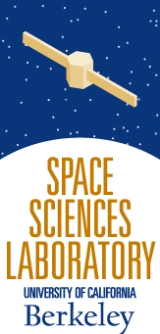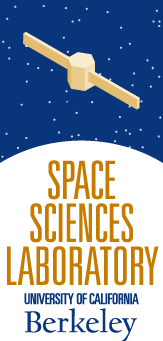
Space Sciences Laboratory
Encyclopedia

University of California, Berkeley
The University of California, Berkeley , is a teaching and research university established in 1868 and located in Berkeley, California, USA...
. It is located in the Berkeley Hills
Berkeley Hills
The Berkeley Hills are a range of the Pacific Coast Ranges that overlook the northeast side of the valley that surrounds San Francisco Bay. They were previously called the "Contra Costa Range/Hills" , but with the establishment of Berkeley and the University of California, the current usage was...
above the university campus. It has developed and continues to develop many projects in the space sciences.
Current work
SSL developed and maintains the SETI@homeSETI@home
SETI@home is an Internet-based public volunteer computing project employing the BOINC software platform, hosted by the Space Sciences Laboratory, at the University of California, Berkeley, in the United States. SETI is an acronym for the Search for Extra-Terrestrial Intelligence...
project which pioneered the application of distributed computing to the space sciences.
It created the related projects Stardust@home
Stardust@home
Stardust@home is a citizen science project that encourages volunteers to search images for tiny interstellar dust impacts. The project began providing data for analysis on August 1, 2006....
and BOINC
Berkeley Open Infrastructure for Network Computing
The Berkeley Open Infrastructure for Network Computing is an open source middleware system for volunteer and grid computing. It was originally developed to support the SETI@home project before it became useful as a platform for other distributed applications in areas as diverse as mathematics,...
.
It is home to the Space Physics Research Group, which does Plasma physics research.
It has developed many satellite missions and serves as a ground station for those missions. Some of the satellites it has developed are:
- The Reuven Ramaty High Energy Solar Spectroscopic ImagerReuven Ramaty High Energy Solar Spectroscopic ImagerReuven Ramaty High Energy Solar Spectroscopic Imager is the sixth mission in the line of NASA Small Explorer missions...
(RHESSI) satellite - The Time History of Events and Macroscale Interactions during Substorms (THEMISThemisThemis is an ancient Greek Titaness. She is described as "of good counsel", and is the embodiment of divine order, law, and custom. Themis means "divine law" rather than human ordinance, literally "that which is put in place", from the verb τίθημι, títhēmi, "to put"...
) satellite constellation - The Fast Auroral Snapshot ExplorerFast Auroral Snapshot ExplorerThe Fast Auroral Snapshot Explorer was launched from Vandenberg Air Force Base on board a Pegasus XL rocket on August 21, 1996. One in the series of NASA's Small Explorer spacecraft, FAST was designed to observe and measure the plasma physics of the auroral phenomena which occur around both poles...
(FAST) - The Cosmic Hot Interstellar Plasma Spectrometer (CHIPSatCHIPSatCHIPSat is a now-decommissioned, but still-orbiting, microsatellite. It was launched on January 12, 2003 from Vandenberg Air Force Base aboard a Delta II with the larger ICESat, and had an intended mission duration of one year...
) - The Extreme Ultraviolet ExplorerExtreme Ultraviolet ExplorerThe Extreme Ultraviolet Explorer was a space telescope for ultraviolet astronomy, launched on June 7, 1992. With instruments for UV radiation between wavelengths of 7 and 76 nm, the EUVE was the first satellite mission especially for the short-wave ultraviolet range...
(EUVE) - The Infrared Spatial InterferometerInfrared Spatial InterferometerThe Infrared Spatial Interferometer is an astronomical interferometer array of three 65 inch telescopes operating in the mid-infrared. The telescopes are fully mobile and their current site on Mount Wilson allows for placements as far as 70 m apart, giving the resolution of a telescope of that...
(ISI)
It does science education outreach via the Center for Science Education (CSE).
History
The Space Sciences Laboratory (SSL) at Berkeley, CaliforniaBerkeley, California
Berkeley is a city on the east shore of the San Francisco Bay in Northern California, United States. Its neighbors to the south are the cities of Oakland and Emeryville. To the north is the city of Albany and the unincorporated community of Kensington...
was initiated in 1958 by a committee of faculty members who recognized that emerging rocket and satellite technology opened up new investigative realms for the physical, biological, and engineering sciences. The committee, chaired first by Professor Otto Struve
Otto Struve
Otto Struve was a Russian astronomer. In Russian, his name is sometimes given as Otto Lyudvigovich Struve ; however, he spent most of his life and his entire scientific career in the United States...
of the Department of Astronomy and subsequently by Professor Edward Teller
Edward Teller
Edward Teller was a Hungarian-American theoretical physicist, known colloquially as "the father of the hydrogen bomb," even though he did not care for the title. Teller made numerous contributions to nuclear and molecular physics, spectroscopy , and surface physics...
of the Department of Physics and the Lawrence Radiation Laboratory, explored with faculty members the opportunities associated with space research as well as the impact of rapidly escalating national space exploration programs (i.e. NASA) on graduate study and research. The committee proposed the formation of a Space Sciences Laboratory which, as a campus-wide multidisciplinary organization, would serve to integrate the space sciences on campus and stimulate new faculty-student research programs. The Regents, acting on the recommendation of Chancellor Glenn T. Seaborg
Glenn T. Seaborg
Glenn Theodore Seaborg was an American scientist who won the 1951 Nobel Prize in Chemistry for "discoveries in the chemistry of the transuranium elements", contributed to the discovery and isolation of ten elements, and developed the actinide concept, which led to the current arrangement of the...
and President Clark Kerr
Clark Kerr
Clark Kerr was an American professor of economics and academic administrator. He was the first chancellor of the University of California, Berkeley and twelfth president of the University of California.- Early years :...
, authorized the formation of the Laboratory in 1959.
The Laboratory began its operations in January 1960 with the appointment of its first director, Professor Samuel Silver. Starting life in a corner of the old Leuschner Observatory on the main campus, the active interest of faculty members in the space sciences led to a rapid deployment of the physical and biological research programs. The modest quarters were soon inadequate for the group of research associates and graduate students. An especially large project on space physiology initiated by Professors Hardin B. Jones and Cornelius A. Tobias required much more space than available on campus, forcing the Laboratory to move to the Ford Assembly Building in Richmond
Richmond, California
Richmond is a city in western Contra Costa County, California, United States. The city was incorporated on August 7, 1905. It is located in the East Bay, part of the San Francisco Bay Area. It is a residential inner suburb of San Francisco, as well as the site of heavy industry, which has been...
, California
California
California is a state located on the West Coast of the United States. It is by far the most populous U.S. state, and the third-largest by land area...
, a property acquired by the University several years earlier.
The space physics program directed by Professor Kinsey A. Anderson and involving experiments carried by balloons, rockets, and satellites quickly outgrew its quarters requiring a move off campus as well. The Laboratory rented a store at 2119 University Avenue, just west of the University, and converted it into a figurative beehive of research activities. At the peak of its use, the "Market" (or the "Shoe Store") as this facility was known, housed electronic shops, the machine shop, the data processing equipment, environmental test equipment, and research projects on the moon and the planets, the interplanetary medium, and the upper atmosphere of the earth. Also housed here were social scientists who were studying the physical scientists and the problems of organization and administration of research.
In its early years, the National Aeronautics and Space Administration followed the policy of funding university research on an individual project basis. It was not until 1961, when Mr. James E. Webb
James E. Webb
James Edwin Webb was an American government official who served as the second administrator of NASA from February 14, 1961 to October 7, 1968....
became the Administrator of NASA
NASA
The National Aeronautics and Space Administration is the agency of the United States government that is responsible for the nation's civilian space program and for aeronautics and aerospace research...
, that the agency formulated a broad and far-reaching program of space research and exploration. The Office of Grants and Research Contracts instituted two programs: the Sustaining Grant Program and the Facilities Program. The Berkeley campus was one of the first universities to receive grants under these two programs.
The Sustaining Grant, which provided the Space Sciences Laboratory with a core of funds for interdisciplinary research in the physical, biological, engineering, and social sciences, gave the Laboratory a foundation on which to build faculty programs and to generate new areas of graduate training through research. The grant was invaluable in developing the space sciences program on the Berkeley campus.
The NASA
NASA
The National Aeronautics and Space Administration is the agency of the United States government that is responsible for the nation's civilian space program and for aeronautics and aerospace research...
Facilities Grant precipitated the construction of SSL's original buildings. The growth of multiple programs represented the fulfillment of one of laboratory's goals, namely to stimulate faculty and student participation in space research. But the second major objective, that of developing the multidisciplinary substance and unique character of space research, could not be realized in a physically fragmented laboratory. With the construction of the new buildings, that goal was finally achieved. The building grant was awarded by the National Aeronautics and Space Administration (NASA) in 1962 and the building dedicated on Thursday, October 27, 1966.
Building and location

Berkeley Hills
The Berkeley Hills are a range of the Pacific Coast Ranges that overlook the northeast side of the valley that surrounds San Francisco Bay. They were previously called the "Contra Costa Range/Hills" , but with the establishment of Berkeley and the University of California, the current usage was...
. The building is directly adjacent to the Mathematical Sciences Research Institute
Mathematical Sciences Research Institute
The Mathematical Sciences Research Institute , founded in 1982, is an independent nonprofit mathematical research institution whose funding sources include the National Science Foundation, foundations, corporations, and more than 90 universities and institutions...
and slightly above the Lawrence Hall of Science
Lawrence Hall of Science
The Lawrence Hall of Science is a public science center featuring hands-on exhibits and activities. Located in the hills above the University of California, Berkeley campus, LHS is also a resource center for preschool through high school science and mathematics education.Established in 1968 in...
. The architects designed the building to fit the setting and give the people inside a feeling of ready enjoyment of their natural surroundings.

